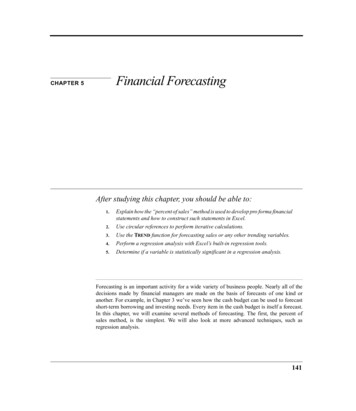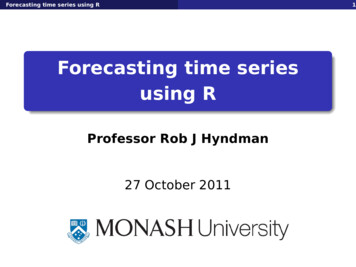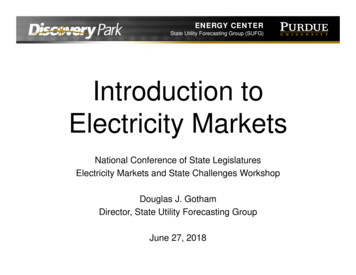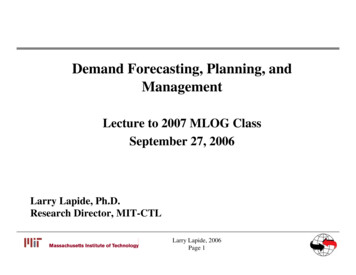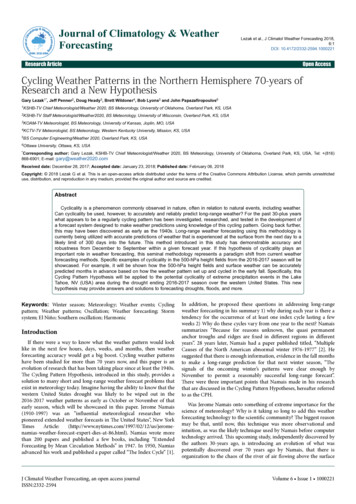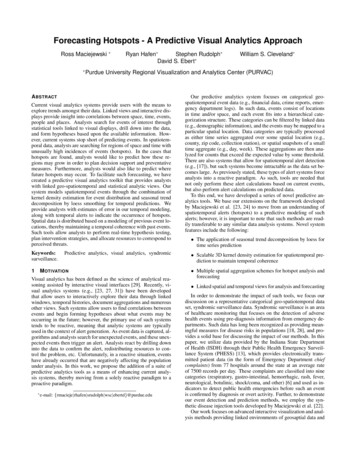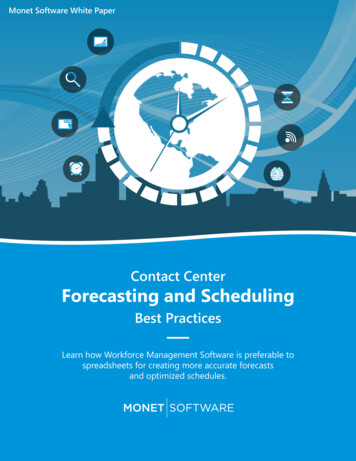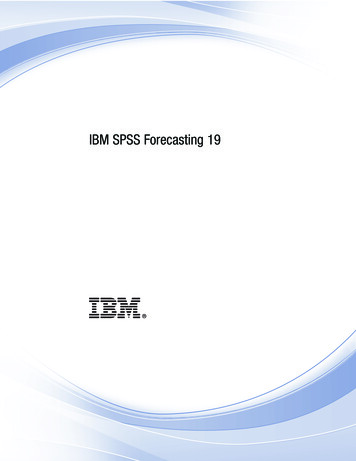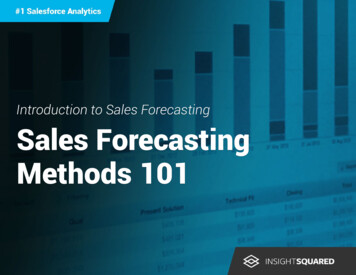
Transcription
Introduction to Sales ForecastingSales ForecastingMethods 101
About the AuthorsZorian RotenbergZorian is a sales and marketing veteran with a proven track record of success in the hightech world. He has brought his passion for improving sales performance managementwith analytics to InsightSquared. Prior to InsightSquared, Zorian was an executive on themanagement teams of several global software companies which he helped to grow by over100% in annual revenues, ranging between 8 Million to over 100 Million. He was alsoCEO at a software company which grew Americas sales by 145% in his first year as CEOusing the best practices of inside sales management. Zorian has a degree in Finance andwith minors in Applied Mathematics and in Computer Science from Lehigh University andearned his MBA from Harvard Business School.Kim LindquistKim can be found at the crossroads of marketing analytics and writing. With a passionfor data-driven decisions, Kim strives to turn numbers into stories that help businessesunderstand their data-landscape. Since graduating from Boston College, where she earneddegrees in English and Communication, Kim has enjoyed working in the lively start-upscene in and around the Boston area.Sales Forecasting Methods 101 // 2
Table of ContentsIntroduction to Sales ForecastingWhy Build a Sales Forecast?Types of Sales Forecasting Methods4612Traditional Sales Forecasting Using Forecasting Stages13Data-Driven Forecasting Using Opportunity Stages16Additonal Methods18Running Your Sales Forecasting Meetings19Set a Schedule for Your Meetings21Invite the Right Team Members22Do Your Research Ahead of Time22Separate Your Sales Forecasting from Your Pipeline Review Meeting23Guidelines for Managing Your Opportunities in the Funnel25Traditional Forecasting by Stage26Data-Driven Sales Forecasting by Stage30Creating Your Most Insightful Sales Forecast32Use Historical Data to Better Predict Future Sales33Consider Other Variables that Impact Opportunity Outcomes34Conclusion35Sales Forecasting Methods 101 // 3
Introduction to SalesForecasting// 4
At the most basic level, sales forecasting is the process of estimating future revenue generatedby your sales team for your business. In most organizations, it is the responsibility of the SalesManager or Sales VP to project and monitor the sales forecast for each selling period. They areresponsible for understanding how sales will perform in the future and informing business leaders.While most sales leaders understand the crucial aspects of sales forecasting, very few of themachieve reliable forecasts—in fact recent industry surveys suggest that only 40% of all forecastedopportunities ever turn into deals. Other than the most obvious reasons to build an accurate salesforecast—to determine whether your team will generate enough revenue to keep the lights on at theoffice—there are other key reasons sales leaders should strive for a trustworthy and analytics-drivensales forecast.“Salespeople despise forecasts because, in most cases, they are being asked to liein writing In fact, the major value of forecasting is that it has the potential togive salespeople with inadequate pipeline a wake-up call 12 times a year —that is,a message from on high that there are inadequate opportunities in their pipeline,and that they must increase business development activities.- Michael T. Bosworth, Customer Centric SellingThis eBook will teach you ways to improve your forecasting process and accuracy and help you turnyour forecasts into a crucial and reliable tool in your sales process.Introduction to Sales Forecasting // 5
Why Build a SalesForecast?// 6
As a baseline, accurate forecasts allow you to focus on revenue-generating activities insteadof dealing with frequent alarms and pipeline risks. As a sales leader, you also want precise andmeaningful sales forecasts for better visibility, planning, budgeting and risk management. Accuratesales forecasting gives you the confidence to identify issues and alert your executives early on,rather than after the fact. Early detection can often be the difference between “We appreciate thealert. How can you fix this?” and “How did you miss this? You’re fired.”Many companies don’t have a process for creating consistently reliable sales forecasts, oftentimes because they use tools like Excel spreadsheets or basic Salesforce reporting when buildingtheir forecasts. These clunky solutions pose a huge challenge for sales leaders who need a simplerway to manage data and report to key business decision makers about the health of the business.Generally these processes are time-consuming, unscalable, and error-prone approaches to salesforecasting.But why are accurate sales forecasts so essential? Knowing the “why” will help you determine howto improve your forecast so that it is a reliable tool for business planning, and a leading indicator ofyour business’ success.Why Build a Sales Forecast? // 7
Top 5 Benefits of ReliableSales Forecasts1. Get a Single Unified View into Achieving Revenue Goals2. Manage Your Team and Sales Performance3. Provide an Accurate Indicator to Your CEO and Board4. Plan Cash Flow5. Plan Post-Sales SupportWhy Build a Sales Forecast? // 8
Get a Single Unified View into Achieving Revenue GoalsEveryone in your company needs to be on the same page: from inside sales reps dialing hundredsof prospects per day to key stakeholders who need to anticipate cash flow and growth for theorganization. The more visibility you have into how you are performing against your revenue goalsthe better. When your organization visualizes and understands goals together, it is easier to strivetowards them, anticipate issues, and make changes to the process to accommodate for successesand failures in your sales cycle.Manage Your Team and Sales PerformanceA forecast is a tool for managing your sales team. How do we look relative to our goal? What dowe need to do to hit our number this month? If you are coming up short in a particular month, yourforecast will alert you to this problem before it happens. In this case, your forecast is about helpingyou to execute a plan for a particular month or quarter and making early adjustments. Coming upshort? Then look for low probability opportunities and try to accelerate them to improve your odds.In this case, you are using your forecast to help manage your pipeline and change the course beforeit is too late to make up the ground you have lost.Why Build a Sales Forecast? // 9
Provide an Accurate Indicator to Your CEO and BoardVery often, the consumer of a sales forecast will be your CEO, VP of Sales or your company’sboard of directors. This group is concerned about making high-level decisions for your business.They might be targeting particular segments, kicking off new expansion initiatives or trying toreinvigorate a lagging element of your business. High-level executives have made strategicbusiness decisions and want to see the earliest predictors of how effective these decisions havebeen. Your sales forecast is a leading indicator that your CEO and board can use to determine theeffectiveness of their decisions.Plan Cash FlowYour CFO cares about your sales forecast as well. She cares because she needs to plan for the cashflow of your business. She wants to know how much business is going to close so that she canplan to cover the expenses. If you are going to come up short of your plan, she wants to know earlyso she has enough cash on hand to make up the shortfall. Maybe she needs to open a line of credit.If you are going exceed your goals this month, maybe she will be more aggressive in negotiatingup-front terms when discussing new deals with your vendors.Why Build a Sales Forecast? // 10
Plan Post-Sales SupportAside from the financial concerns your CFO is worrying about, you may also have a services orsupport team waiting on the other side of the sales process to take care of your newly mintedcustomers. The services team probably doesn’t care much about the finances of your company;their primary concern is in providing great customer service. That means they need to be ready forthe customers who hit them.The VP of Services is going to care about the pure number of deals. He’s asking questions like “Howmany new customers will we need to onboard?” “Do we have enough consultants?” and “Will wehave enough staff on-hand for handling customer support inquiries on the phone next month?” YourVP of Services wants a customer-centric forecast to be ready with the right execution for helpingyour new customers.These are just some of the many reasons why more accurate sales forecasts make for healthier,more balanced businesses. Now that you understand the benefits of producing reliable salesforecasts, here are several sales forecasting methods to consider.Why Build a Sales Forecast? // 11
Types of Sales ForecastingMethods// 12
Depending on how your organization runs its sales team and forecasting processes now, there areseveral sales forecasting techniques that your organization can choose from when determining howto build a sales forecast.Traditional Sales Forecasting Using Forecast StagesMany sales organizations use traditional forecast stages to generate their sales forecast.Independent of the milestones hit by opportunities, sales reps and managers are asked to makea qualitative assessment of their opportunity. This type of forecast is based on the sales rep’sintuition rather than on metrics.Qualitative Forecast Stages are typically categorized as follows Pipeline: “I’ve created this opportunity.” Best Case or Upside: “If things go our way, this could come in.” Strong Upside: “There is a good chance this deal will land.” Commit: “I am committing to bring this in.” Worst case: “We will only close the committed opportunities.”Types of Sales Forecasting Methods // 13
Sales managers use these assessments to build out different scenarios for the consumers oftheir forecasts (CEOs, CFOs). The figure above demonstrates this view in a typical Salesforce.comaccount.Types of Sales Forecasting Methods // 14
Pros of Using Forecasting Stages A sales rep can say, “This deal is early, but I’m putting it in Commit.” This practice is morecommonly followed by sales teams with longer sales cycles and external field sales teams. The forecast is easy to implement and execute, and is a well-known process in most organizations. Sales leaders are able to capture the qualitative data their reps are gathering.Cons of Using Forecasting Stages Forecast stages are entirely qualitative, making it challenging to measure accurately. Salespeople on the tail of a good meeting will have “happy ears” (they will only hear the good inany prospect’s answer) and may project overly optimistic numbers. Sales reps can “sandbag” deals to pad their numbers, which greatly hurts the ability to predictbookings accurately.Ultimately, qualitative forecasting methods ask the owner of the opportunity to also do the analysisof the opportunity. This is akin to asking a motivated dieter to guess their weight loss this week,rather than measuring it on a scale. Although this method is easy to implement, the subjectivenature of this type of forecasting makes it susceptible to large margins of error.Types of Sales Forecasting Methods // 15
Data-Driven Sales Forecasting Using Opportunity StagesIn CRM systems such as Salesforce.com, each of your opportunities has a status or opportunitystage. Each stage represents a milestone that you work towards to take a validated salesopportunity across the finish line. In the software world, these stages might be steps likeProspecting, Qualifying Needs, Assessment, Presentation, Negotiation and Closed-Won. Each ofthese stages will have a “probability of closing” associated with them: an opportunity in an earlystage might have a 10% probability of closing, whereas a later stage (like “Submitting Quote”) mighthave a 90% probability of closing.Using this method, sales leaders can create a basic forecast by multiplying the amount associatedto each opportunity byeach opportunity’sprobability of closing,for opportunitiesexpected to close thisperiod (i.e. those witha close date set in theCRM to this salesperiod). The figure tothe right is a quickexample.Types of Sales Forecasting Methods // 16
Pros of Using Data-Driven Sales Forecasting The math here is easily understood. The method is highly objective. The sales rep is not asked for a self-diagnosis, meaning theemotional element is largely eliminated. If it is in an early stage, the probability of closing is low, no matter how good the sales rep feelsabout the opportunity. With concrete definitions associated with a stage, it’s harder for sales reps to blur stages.Cons of Using Data-Driven Sales Forecasting The probabilities associated with different stages are rarely tested or rigorously derived. A conventional pipeline forecast will not account for opportunities that will close in that period buthave not yet entered the pipeline. The shorter your sales cycle, the bigger this issue becomes. This approach is reliant upon having accurate close dates in your CRM. Sales leaders often have tomonitor reps to ensure they update their close dates with this method.Although this method is more quantitative, some variables are not taken into account in opportunitystage forecasting including deal size, individual rep close rate, and opportunity age. Be aware ofother elements that affect your forecast and look for ways to drill down further than just stage.Types of Sales Forecasting Methods // 17
Addtional Forecasting MethodsThere are also more complex sales forecasting methods that can be applied with proper data. Onesuch advanced method uses the length of the sales cycle to adjust the expected value of youropportunities. By comparing the age of each opportunity to the typical length of your sales cycle forwon and lost deals, you can algorithmically calculate the likelihood the opportunity will close in theperiod that you are forecasting.Additionally, more sophisticated analysts can use multivariate regression models to analyze multipleelements together at once, or hazard analysis to identify multiple risks in their forecast variables.The math in these approaches can get complex quickly, which is why more advanced reporting andanalytics solutions are useful. That way you, as a sales manager, can focus on your strengths andleave the elaborate formulas to the MIT Ph.Ds. behind the scenes.Types of Sales Forecasting Methods // 18
Running Your SalesForecasting Meetings// 19
After you define how you will measure your opportunities and sales progress in your salesforecast, you will need to set a structure for keeping reps on task in their forecasting. Regularsales forecasting meetings are intended to make sure the data in your forecast is up-to-date andaccurate, but the ultimate objective is to help coach and manage your reps to succeed in achievingtheir quota.Your sales forecasting meetings should focus on accurately forecasting the deals that will close thismonth and quarter. During this meeting, you should inspect each deal to understand whether it hasa good probability of landing during this sales cycle.You should also understand What the total forecast is for the current period What has changed from before What strategies to use to close forecasted deals Where reps need to purge stalled opportunities from their forecastsThe sales forecasting meeting is not meant to help with future deals--it should only focus onhelping reps succeed in the present selling period.The following section will walk through the steps it takes to conduct your best sales forecastingmeetings.Running Your Sales Forecasting Meetings // 20
Set a Schedule for Your MeetingsMost sales teams meet weekly, typically each Monday morning, to discuss their forecasted dealsfor the week. Monday meetings allow the team to check-in and analyze deals that are forecastedto close in the immediate sales cycle. This way both sales managers and reps are able to addresswhich opportunities they will be working on in the immediate term and which opportunities havechanged (stalled, changed value, pushed back their close date) that may need to be purged from theforecast for the current sales cycle.Even if your business has an atypical sales cycle or fewer opportunities, you should maintaina weekly sales forecasting meeting: this way you can monitor the nuances of these criticalopportunities, and identify the changes that could drastically impact your sales outcomes.Running Your Sales Forecasting Meetings // 21
Invite the Right Team MembersTo make sure you are using your sales team’s time effectively, invite the team members who willdirectly impact your sales forecast and who will see the direct impact of your sales forecast: yourInside Sales Reps and Sales Executives. As the sales manager, you should aim to have everymember in the meeting objectively assessing and in agreement with your current forecast. Use thistime to set the right expectations with your Sales Executives about what is possible for this salescycle, based on the data. Feel free to have this be an “open invitation” meeting to all team members,but make sure it is mandatory that your reps and sales leaders are both in the room each week.Do Your Research Ahead of TimeKnow the questions you are going to ask and the objectives for each sales forecasting meetingyou conduct. Do you know your typical sales cycle length? Your reps’ average sales cycle lengthby stage? Each rep’s individual win rate? Your historic sales funnel conversion rates? Make sure tohave these metrics, as well as other mission-critical information readily available at your meeting tocompare and analyze the probability of opportunities that are forecasted to close this sales periodagainst your historic performances.Running Your Sales Forecasting Meetings // 22
Separate Your Sales Forecasting from Your Pipeline Review MeetingFinally, in order to be successful as a sales manager you must differentiate between your salespipeline review meeting and sales forecasting meeting. Though both meetings are meant as a wayfor sales managers to monitor leading indicators and sales, they both have a distinct focus andobjective.In your pipeline review meeting, focus on top of the funnel: opportunities in the pipeline that areprojected to close outside of the current period. Your reps need to build their pipeline for the futureto ensure their (and your organization’s) success. You need to have enough leads and opportunitiesthat will make it down to the last few opportunity stages in your sales funnel— the very opportunitiesthat will move down to later stages and the ones that you will ultimately end up discussing in thefuture period’s forecasting meeting.By separating these two meetings, you will be able to focus on the immediate task at hand in yoursales forecasting meeting: identifying and coaching reps to close deals in this forecasting periodthat are winnable. You will also be able to analyze and purge opportunities in the forecasting periodthat will not close.Running Your Sales Forecasting Meetings // 23
Your forecasting meetings are the meetings that take the pulse on the projected health of yourbusiness, and these planning steps should be added into your weekly sales forecasting meeting.You may also want to look for early warning signs in addition to these steps as you prepare for yourmeetings, such as struggling reps and your monthly progress versus your forecast predictions.In this way you will be able to make the most of your forecasting meetings, and prepare to lookobjectively at the elements of your forecast that are most likely to sabotage your most accuratesales forecast.Running Your Sales Forecasting Meetings // 24
Guidelines for ManagingYour Opportunities in theFunnel// 25
Whether you choose to implement a Traditional Sales Forecast or a Data-Driven Sales Forecast, youneed to put best practices in place.Here are the guidelines to follow stage-by-stage when establishing your sales forecasting methodof choice.Developing Your TraditionalForecasting StagesIn the case of Traditional Forecasting,consider each stage of your salesprocess as a checklist that must befollowed in order to pass to the nextstage. In each stage, you will want tofollow certain guidelines to create aconsistent and repeatable processthat will better align your sales forecast.Guidelines for Managing Your Opportunities in the Funnel // 26
PipelineWhen a rep creates an Opportunity, it means that it is now in the Pipeline. Unless you have atransactional business model, you will generally close deals in the pipeline at least a quarter afterthey enter it, but it is critical to measure this carefully and see what the full Win and Loss cycles arefrom your top stages of the Pipeline.Identify the following key elements before you convert a lead to a contact and simultaneously createan opportunity. This ensures that your pipeline has integrity. Initial Contact: The rep has identified the contact with authority or influence over the purchaseand has engaged him or her. Budget: The contact confirms that he has the budget. ROI: The contact has indicated that there is ROI in purchasing your product and explains why. Need: There is a pain identified and the contact confirmed that your product will solve that pain.Guidelines for Managing Your Opportunities in the Funnel // 27
Best Case, Upside, or Strong UpsideThe sales rep usually marks the opportunity in this category if he or she feels very strongly that itwill close during this selling period if everything goes right. The opportunity does not yet satisfy therequirements of the Commit stage but falls into either Best case, Upside or Strong Upside. Confirmthe following key elements in any of these stages Authority: The rep has established a good rapport with the contact and has identified real decisionmakers and all other influencers besides his existing champion in this deal. Timeline: The contact has indicated the evaluation timeline and the rough date of purchase. Process: The rep understands the purchase process. Written Confirmation: The sales rep has received a written confirmation from the contact onauthority, budget and pain. Competition: The rep can confirm that he is aware of which competitor he is running against andthat, if there is competition, it is considered seriously as part of a formal evaluation process. Winning: The rep can describe the key reasons why he/she believes he/she is going to win thisdeal. Compelling Reason to Act (CRA): The rep can confirm that he has created a compelling reason toact with the prospect.Note that there should always be some good Best Case or Upside opportunities to backfill anypotential opportunities in the Commit stage that may be missed, as with this forecasting method,this happens on occasion.Guidelines for Managing Your Opportunities in the Funnel // 28
CommitThe rep expects these opportunities to close during the current selling period. Sometimes managersrefer to these as “Blood Commit” or “Career Commit” to ensure that these have real integrity and willnot slip under any circumstances. Authority: The rep is engaged with all influencers and the final decision maker. If this is not thecase then there is a risk that his main champion could be absent when needed, putting theopportunity at risk. He/she knows who signs the purchase order and understands who may bepotentially a deal detractor that may come in at the eleventh hour to veto the purchase order andhas thus already engaged with this person as well. Process: The rep knows and has confirmed the purchase process in writing and doesn’t leaveanything to chance in the eleventh hour. Catalyst: The rep knows the exact event or a catalyst for why the prospect needs to purchase thesolution during this selling period. Confirmation: The decision maker confirms in writing that your product was chosen.Closed-WonA deal is closed-won only when the purchase order has been received and not a minute earlier.Guidelines for Managing Your Opportunities in the Funnel // 29
Developing Your Data-Driven Sales Forecasting StagesIn the case of Data-Driven Sales Forecasting, focus your attention on formally constructing yourstages and defining how opportunities progress from stage-to-stage.Construct Your StagesUnlike Traditional Sales Forecasting, forecasting by opportunity stage should focus on definingand standardizing your own objective stages of the buying process. These stages can be named bydescription based on the buyer stages in your sales process, such as Prospecting Demo Scheduled Demo Completed Trial Negotiation Closed-WonOr you can standardize by number “Stage 1”, “Stage 2”, “Stage 3” depending on your preference.Developing sales stages makes each opportunity quantifiable. When a prospect moves into Stage2, your rep has identified the DMU (decision making unit) who will sign the contract. This stagedefinition is discrete and measurable, unlike feelings-based traditional stages.Guidelines for Managing Your Opportunities in the Funnel // 30
Formally Define Your Sales ProcessNext, plan to thoroughly define your entire sales process and document it to make sure that yoursales team clearly understands qualification rules, your sales system and the discrete stagesthrough which an opportunity moves to Closed-Won based on the buyer’s actions. It is crucial todefine the transition from one stage to the next based on the buyer’s actions, not steps in yourselling process. For example, an opportunity should not be moved from Demo Completed to Trialuntil a buyer has explicitly given all of the collateral the seller needs to start the Trial process.Guidelines for Managing Your Opportunities in the Funnel // 31
Creating Your MostInsightful Sales Forecast// 32
The best sales forecasts not only provide reliable projected bookings but provide insight into thecomposition of winning and risk-bearing opportunities. Unfortunately for sales managers using thequalitative stages of traditional forecasts, additional data-driven insights are almost impossibleto incorporate. Using the following elements in your forecasting process will provide you withadditional analysis and improved accuracy above and beyond a basic sales forecast.Use Historical Data to Better Predict Future SalesIn order to achieve insightful forecasts that account for past performance and trends, salesmanagers need to analyze their historic data. To further hone the accuracy of your forecast, includemetrics like Your sales team’s projected win rate against historic team win rates by stage. Your sales rep’s win rate by stage. Your overall sales funnel conversion rates from Stage 1 to Closed-Won.Although this data is not impossible to gather, most CRM systems do not provide access to legacysales data, which can be a challenge. In the case that your CRM does not provide historic snapshotsof your data, your sales team will need to diligently download and store your data weekly in order tocreate reports and see progress over time. Alternately, consider using a third-party tool to accessand visualize this data.Creating Your Most Insightful Sales Forecast // 33
Consider Other Variables that Impact Opportunity OutcomesOther underlying elements can have a dramatic impact on the accuracy of your sales forecast. Somebasic variables to consider are Age: to identify the average age of your Closed-Won and Closed-Lost opportunities. Stage: to ensure that opportunities in the forecast period are not too early in the buying process torealistically close. Deal Size: to be able to focus on the size of your opportunities to determine how likely you are towin them. Lead Source: to compare the likelihood you will win an opportunity based on data from your pastefforts with this source.Ultimately, any variable that can affect the outcome of your sales forecast should be measurable inorder to identify and adjust for outliers in your forecasts. To get a more in-depth understanding ofthese variables, download InsightSquared’s Definitive Guide to Data-Driven Sales Forecasting.Creating Your Most Insightful Sales Forecast // 34
Conclusion// 35
Like all sales managers, you need a sales forecast to manage your team, plan and budget moreaccurately, set more realistic expectations for your organization, and ultimately to help growrevenue.Whether you choose to implement a traditional sales forecast, a data-driven sales forecast byopportunity stage, more advanced forecasting methods or 3rd party forecasting products likeInsightSquared, the first step to creating accurate sales forecasts is getting started. From there youcan measure your forecast against your monthly and quarterly bookings to assess how close youare to your most accurate and risk-free sales forecast and continue to make improvements.Even with data-driven opportunity stage forecasting, there are some highly complex formulasand reports that are not readily accessible via Excel spreadsheets and CRM systems. In thesecases, products that allow you to better visualize and analyze your data are often the best-casealternatives to accessing and analyzing your CRM data quickly, visually and accurately.If you are interested in learning more about data-driven sales forecasting and automating yourforecast, request a free trial of the “Smart Forecast” and other InsightSquared reports by reachingout via email or by clicking below.Conclusion // 36
#1 for Salesforce Analytics Get Actionable and Instant InsightsIncrease Rep ProductivityClose EVEN MORE DealsUse Smart Forecast
About InsightSquaredInsightSquared provides disruptive and breakthrough sales and marketing analytics for Salesforce.The analytics, dashboards and reports are built from the ground up for sales managers and businessexecu
Sales Forecasting Methods 101 // 2 . several sales forecasting techniques that your organization can choose from when determining how to build a sales forecast. . these stages will have a “probability of closing
